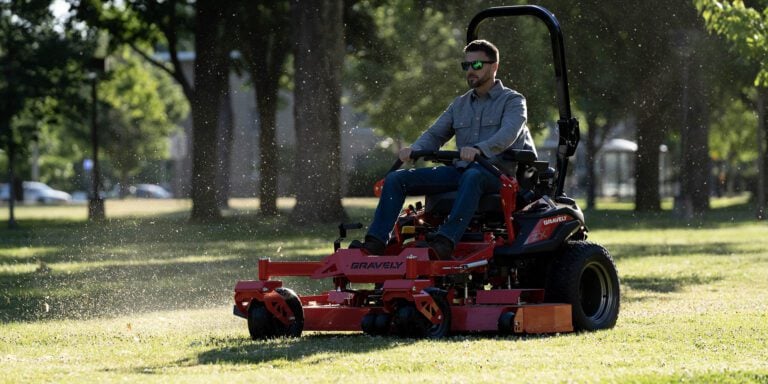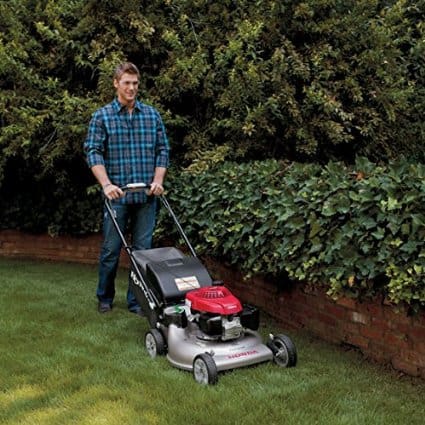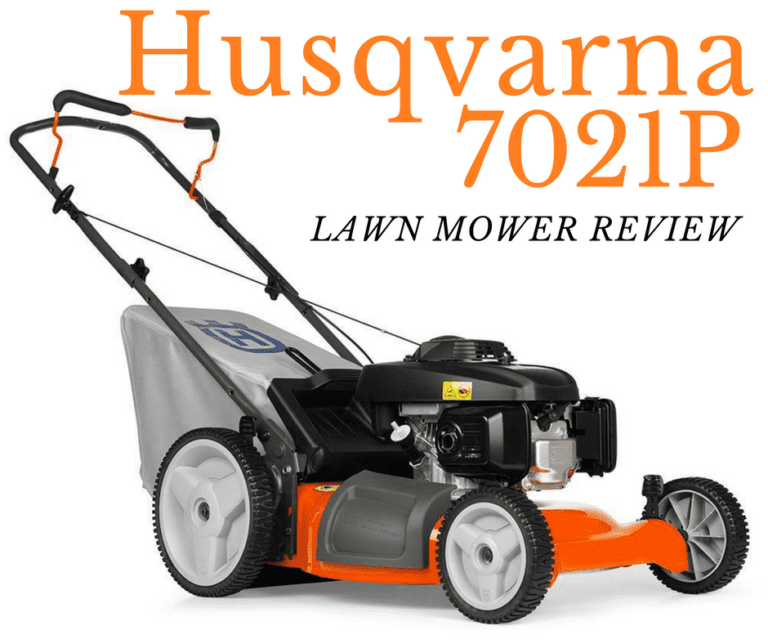11 Best Weed And Feed For Lawns – How & When To Use Them
There’s one thing that garden novices, as well as experienced gardeners, aspire to most in their garden: a green weed-free lawn.
This isn’t as easy as it sounds because weeds are tough and sprout up almost everywhere. That’s why you will need to find a good-quality herbicide and a great lawn fertilizer to get your weeds under control.
The best option for lawn weeds is 2-in-1 weed and feed products. They deal with the weeds and feed the lawn for better growth at the same time.
With the many different products available and different ways of applying them, you are spoilt for choice.
Still, it doesn’t have to be difficult to use weed and feed and create a beautiful, luscious lawn. Here are our top 11 weed and feed products and the best way on how to use them.
When Best To Apply Weed And Feed To Your Lawn?
For you to get the most from your 2-in-1 weed and feed product for your lawn it is essential to get the timing right. As a general rule, you should apply the product during the active gardening season from April to August.
If it’s too early, the weeds are just developing and you may not catch all of them. Also, consider how the fertilizer works. Fertilizer supports healthy grass growth and improves its foliage as well as the grass root network.
Applying the weed and feed too early can lead to much more top growth while limiting the root production. This means the grass is weaker and you would have to mow your lawn more often.
Lawncare In Spring
For feeding your lawn in spring it’s best to use a weed and feed to control any moss growth and also helps your grass to grow stronger, plus it also kills off all the common weeds.
When the moss and weeds are under control later in the spring, you can move on to a general lawn feed that helps to keep your grass looking thick and lush.
The best for this is liquid lawn feed as you can use them with a hose pipe and they water the lawn at the same time.
Lawncare In Summer
If it’s a hot summer, the grass of your lawn stops growing and it does not use any feed.
During dry periods lawns start to get stressed and could be damaged if you apply weed killer or fertilizer. Try not to feed your lawn during hot spells, instead wait until it has rained and allow the water to soak in for a few days.
Then you can start applying lawn fertilizer again in 6-8 weeks intervals across the summer.
Lawncare In Fall
There are some good weed and feed products available particularly for fall. At this time of year, your grass will need a slightly different fertilizer as it grows at a slower rate and it prepares the lawn for winter by growing stronger roots that can withstand the cold.
Lawn weed and feeds designed specifically for fall have a low nitrogen content as they don’t want to encourage foliage growth, which could be easily burnt by frost.
Feeding your lawn in fall can encourage strong root growth so that the lawn can recover again quickly from the cold winter.
Keeping your weeds out of your lawn is a continued struggle throughout the year but if you follow the instructions on your weed and feed product then you will have the exact details on when best to apply it.
How Does Weed And Feed For Your Lawn Work?
Weed and feed products work in either of two ways. Some prevent the weed’s protein product by blocking photosynthesis, others damage the root of the weed so that it dies off.
At the same time, the fertilizer encourages healthy grass blade growth that leads to better lawn density. The denser and thicker your lawn is, the fewer weeds can germinate and grow as the grass crowds out the competing weeds.
When it comes to applying weed and feed the timing is everything. If you apply the product at the wrong time of year you may get inconsistent or poor results, or you could even damage your lawn.
When You Apply Weed And Feed Too Early
If you apply weed and feed too early in the season, the grass of your lawn may get much more fertilizer than it really needs and this can lead to fertilizer scorch.
The majority of grass types will need more nutrients while they actively grow from mid-spring onwards.
For this reason, weed and feed has been designed to release nutrients slowly. This means when you apply it around April time, it will support grass growth right at the time your lawn needs nutrients.
When You Apply Weed And Feed Too Late
If you opt to apply weed and feed later in the season, for example, in September, it reduces the effectiveness of the treatment.
While September is a good time to kill and treat weeds, it’s not the best time to apply fertilizer to the grass as this would fuel top foliage growth.
This also leads to weaker roots over winter. However, if you want to get rid of your weeds in the second half of the year you are better off by using a stand-alone weedkiller for lawns in September, and then apply a separate lawn fertilizer in October.
How Long Does Weed And Feed Take To Work?
Depending on your grass and weed type, and your chosen product, it can take between 4 days and one month to see any visible results.
The first thing you’ll notice is that moss, dandelion, clover and other weeds turn brown or black, and die off.
How Long Does Weed And Feed Last?
Most weed and feed products come with their own recommendations on how long they can last.
Generally, weed and feed can be applied either once, twice or regularly throughout the growing season. This depends on your chosen product.
Different Types Of Weed And Feed
Weed and feed comes in two forms, granular and liquid. Both these products are very effective at killing weeds and fertilizing your lawn. Each has slightly different properties so they lend themselves for different lawn and weed types.
Pre-Emergent And Post-Emergent Weed And Feed
In addition to the different form weed and feed (granules or liquid) comes in, there are two types of weed and feed: pre-emergent and post-emergent weed and feed. For the omptimum results you need to know what type you want for your lawn.
Pre-Emergent Weed And Feed
Pre-emergent herbicides kill weeds before they grow, so you can apply pre-emergent weed and feed on established lawns where weeds are already under control.
Pre-emergent weed and feed is ideal to eliminate stubborn crabgrass and Japanese stilt grass.
However, even if you completely removed the weeds the previous year, they could still return as weed seeds fly through the air and settle on the lawn.
For this reason, you should apply the product in early spring each year to prevent weeds from growing.
Post-Emergent Weed And Feed
Post-emergent weed and feed kills weeds that are already grown. You can choose the frequency of how often you apply the product depending on how bad the weed growth is in your yard.
You can use post-emergent herbicides for the removal of bermudagrass and nimblewill.
However, if your lawn has too many weeds, it might choke the grass and you need to check with a landscaper or gardener for more advice.
Liquid Weed And Feed
Liquid weed and feed is applied by using a spray, either as a concentrate diluted with water. For this, you need to use your own garden sprayer to apply it.
Alternatively, some products also come in a convenient hand-held sprayer that is easier to use for smaller areas.
The advantage of liquid weed and feed is that you can apply it to patches or specific areas of your lawn. It acts fast and there is no need to water the lawn before or after application.
Granular Weed And Feed
If you have larger areas of lawn, then granular weed and feed is the better option. You will need to pre-water your lawn and then use a drop spreader to apply the product. This allows for a more consistent spread across the lawn.
Granular weed and feed are better value for money. They are also designed with a slow-release formula, which means nutrients are released into the lawn over time, so you don’t have to apply the treatment to your lawn as often.
Weed And Feed Safe For Family And Pets
For all families and pet owners, the safety of any weed and feed product is essential, especially when you spend a lot of time in your garden. Manufacturers have created products with this in mind.
The majority of weed and feed products state on the label that you should keep children and pets away from the treated lawn for at least 24 hours after application.
This is either because the weed and feed could stain surfaces which could ruin clothes and shoes, especially for children and pets that could pick the material up. Or the product contains hazardous ingredients that are dangerous if consumed.
Please read the product label and the manufacturer’s guidelines carefully so you can make sure that your family and pet are safe.
Organic Weed And Feed
True organic weed and feed products are difficult to find, and even if they are labeled as organic, they may prove to be not as effective as a standard synthetic weed and feed.
The primary ingredient of most organic weed and feed is corn gluten meal which is safe when you come into contact with it. This makes them more child and pet friendly.
Quick Comparison: Top Picks For Weed And Feed For Lawns
[wptb id="507824" not found ]AT A GLANCE: Our Top Picks for Weed And Feed For Lawns
- Our Top Pick: Greenview Fairway Formula Fertilizer + Crabgrass Preventer
- Preen One Lawncare 3 In 1 Weed And Feed
- Pennington Weed & Feed UltraGreen Lawn Fertilizer
- ioAdvanced Weed & Feed All In One Crabgrass Killer
- Scotts WinterGuard Fall Weed And Feed
- Espoma Organic Weed Preventer Plus Lawn Food
- Scotts Turf Builder Weed And Feed
- Spectracide Weed & Feed 20-0-0
- Scotts Liquid Turf Builder Weed And Feed Spray
- Andersons Professional Surge Weed and Feed
- Scotts Turf Builder Starter Food for New Grass Plus Weed Preventer
Our Best 11 Weed And Feed Products For Your Lawn
Here is a list of our top 11 weed and feed products by the most popular brands, including reviews, how to use it, as well as pros and cons.
Best Overall: Greenview Fairway Formula Fertilizer + Crabgrass Preventer

Greenview advises that this improved 65% nitrogen formula feeds the grass for up to 3 months and it kills 200 species of feeds.
How to use it: Use a broadcast or drop spreader to apply this granular weed and feed on a wet lawn in early spring. You will have to wait 3 days before mowing the lawn.
As this weed and feed formula is slow-releasing, you should only use it on healthy and established lawns, as it might stunt growth on new grass.
Pros
- Powerful nitrogen-based lawn fertilizer
- Requires application every 3 months
- Noticeable results after 1 month
Cons
- Should be used on established and healthy lawns only
- Be careful not to spread near trees or other shrubs
Customer Reviews
Some users noticed greener and thicker lawns, while others felt there was little change as it didn’t kill crabgrass. Some users also advised of the negative impact on nearby trees and shrubs.
Runner Up: Preen One Lawncare 3 In 1 Weed And Feed

If you’re a lawn care professional then this product is great but as an average gardener applying feed and weed more than twice a season is a lot to ask.
How to use it: Wet your lawn lightly with a hosepipe and then apply with a broadcast spreader every 2 months. If your weeds are persistent, then you can apply this every month.
Pros
- Easy application with a broadcast spreader
- Visible results in less than 1 month
- Kills up to 250 weed species
Cons
- Requires several applications per season for best result
- You shouldn’t use this product on St. Augustine grass, colonial bentgrass, dichondra or carpet grass
Customer Reviews
Overall, most users were happy with the result of a thicker and healthier lawn. Users also noticed that the spreading of the granules created almost no dust and it worked on the majority of the weeds.
Alternative: Pennington Weed & Feed UltraGreen Lawn Fertilizer

It acts fast and lasts for up to 3 months. This weed and feed kills more than 250 species of weeds and slowly encourages greener grass growth.
It’s safe to use for both warm and cold grass, but should be avoided with St. Augustine grass.
How to use it: You can the Pennington weed and feed with a spreader in late spring between April and June. Then weeds are actively growing.
Pros
- Helps grass to grow quickly
- Excellent value for money
- Noticeable results within 2 months
Cons
- Do not use with st. Augustine grass
Customer Reviews
Overall users were satisfied with this nitrogen-based fertilizer. They were also happy that it covers up to 5,000 square feet of lawn.
Alternative: BioAdvanced Weed & Feed All In One Crabgrass Killer

The combined formula of weed killer and fertlizier kills crabgrass, dandelions and other grassy weeds as well as feeding your lawn.
It helps the grass to grow health roots so it becomes more resistant to drought and heat. However, you should only use this product for certain turf types, including Bermudagrass, Fescue, Zoysiagrass, Kentucky Bluegrass, Ryegrass, Buffalograss, and Seashore Paspalum.
How to use it: You can cover up to 10,000 square feet of lawn with BioAdvanced weed. Simply use a drop or rotary spread to apply the granules evenly. Start at the lawn borders and work your way to the center.
Pros
- Powerful lawn fertilizer
- Requires only one application per season
- Results noticeable after 1 month
- Covers up to 10,000 square feet
Cons
- Only suitable for certain types of grass
Customer Reviews
It only takes a month to notice visible results with this weed and feed. Users saw healthy and thick lawns but also noticed that the product doesn’t work with every grass type.
Alternative: Scotts WinterGuard Fall Weed And Feed

How to use it: Water the grass and apply the granules with a broadcast spreader. For the best results, apply the product in fall. This will help prepare the grass for the next growing season.
Pros
- Makes grass thicker and greener
- A good crabgrass preventer that also eliminates stubborn weeds
- Improves lawn’s water absorption rate
Cons
- Make sure that dosage is right or it can burn the lawn
Customer Reviews
Users of Scott’s weed and feed for fall noticed their grass being a lot greener over the winter months.
Alternative: Espoma Organic Weed Preventer Plus Lawn Food

With its 9% nitrogen content, it gives your lawn the nutrients it needs, while also killing weeds like buckhorn plantain, catchweed bedstraw, curly dock, dandelion, purslane, redroot pigweed, velvetleaf, annual bluegrass, barnyard grass, large crabgrass, quackgrass and many others.
How to use it: For this weed and feed Espoma recommends an application twice a year, ideally in spring and fall. You can apply this product on the dry lawn that has been recently mowed.
In order to spread the granules evenly, use a broadcast spreader working your way across the lawn with some overlap so to cover everything. If rain is not expected within 24 hours after the application, ensure to water the lawn lightly.
Pros
- Organic feed and weed with 100% corn gluten meal
- Ideal for families and pets
- Effective for most common weeds
Cons
- Should be used on established lawns only
Customer Reviews
Customers of Epsoma’s organic weed and feed bought the product mainly for its organic properties. They noticed that you should apply a heavy and results showed very quickly.
Users advised that it shouldn’t be used before heavy rain showers as this can wash the weed and feed away.
Some users also noticed that it only prevents new weeds from reseeding and doesn’t remove established weeds.
Alternative: Scotts Turf Builder Weed And Feed

The weedgrip technology then allows the granules to attach themselves to the weed foliage making an effective and direct weed killer. As the fertilizier formula strengthens the grass roots, it also makes it lush and green.
Scotts’ turf builder doesn’t only kill most common weeds, but it also feeds common grass, such as fescue and ryegrass. However, it is best avoided on warm-season turfs like carpet grass and St. Augustine grass.
The only big caveat with this particular weed and feed is that you need to apply it every 6 weeks for 4 applications, from early spring until late fall.
How to use it: Scotts’ weed and feed is a granular formula so it needs to be applied with a rotary or drop spreader.
For the best results, water your lawn before application, and avoid moving or watering your lawn for 24 hours after application.
Pros
- Covers up to 5,000 square feet
- Kills a range of common weeds
- Best used between spring and fall
- Quick and easy to apply with a drop spreader
Cons
- Very frequent application – every 6 weeks
- Suitable only for bermuda grass, fescues, kentucky bluegrass, centipede, ryegrass, and zoysia or bahiagrass
Customer Reviews
Considered one of the best dandelion killers, Scotts’ weed and feed was found to be very satisfactory for most users.
Customers were overwhelmingly happy with the results proving greener grass and a lot fewer weeds. users report the product as very easy to apply using a handheld broadcast spreader or drop.
Results show greener grass with no sign of weeds within a matter of weeks. Considered one of the best dandelion killers on forum feedback and customer reviews.
Alternative: Spectracide Weed & Feed 20-0-0

The 20% nitrogen formulation of this lawn fertilizer helps to support your grass with the nutrients it needs to grow lush and green.
This liquid weed and feed comes in a practical quick-flip sprayer bottle so there is no need for mixing, and you can get started treating your lawn straight away.
How to use it: Start by shaking the bottle well, then connect the sprayer nozzle to your garden hose. Make sure the switch is initially in the off position.
Turn on the water at the faucet and start working across the area furthest away from the faucet so you don’t step on the treated area.
Simply point the nozzle towards the area you want to treat, pull the switch backward and the water will automatically mix with the product. If you want to stop spraying, just push the switch forward towards the nozzle.
Pros
- Covers up to 7,500 square feet
- No complicated mixing
- Effectively kills common weeds such as dandelion, chickweed, knotweed, plantain and many other broadleaf weeds
Cons
- Covers a smaller area than granules or powder
Customer Reviews
Customers of the Spectracide weed and feed were very happy with the weed filler. It effectively worked for chickweed and dandelion. Users were very satisfied with the easy-to-use spray bottle.
Alternative: Scotts Liquid Turf Builder Weed And Feed Spray

While it’s better to use granular or powder weed and feed for larger lawn areas if you have small amounts of lawn that need treating a liquid spray is your best option.
How to use it: Simply connect your hosepipe to the top of the bottle and use the spray on the areas you want to target. One bottle of Scotts weed and feed can cover up to 6,000 square feet of lawn.
Pros
- Handy hose spray bottle
- Quick and easy to use liquid weed and feed
Cons
- Suitable only for smaller areas
- More expensive compared to granules or powder options
Customer Reviews
Customers liked the easy-to-use spray bottle and that this product created no dust.
Alternative: Andersons Professional Surge Weed And Feed

Andersons’ claims that with their smaller size particle weed and feed you get greater cover per square inch, which will give you a better result.
The nitrogen-based formula is slow releasing so provides your grass with nutrients over a longer time.
How to use it: Spread this weed and feed on the damp lawn and wait for 24 hours after application to water the lawn again.
Surge weed and feed should be applied only on established grass, but you can also apply it on newly seed cool season turf (after the third mowing as the grass should have a root system established).
If you want to apply the weed and feed on warm season turf, it is best to wait until 3 or 4 weeks after the sodding, sprigging or plugging is done, and then only use small amounts.
Pros
- Kills more than 250 species of broadleaf weed
Cons
- Needs application every 6 weeks
Customer Reviews
Customers were very happy with this weed and feed product. They really liked that it killed the majority of garden weeds, such as dandelion, clover and plantain.
Users have noticed that it is slightly more expensive than other weed and feed products but it does an excellent job.
Alternative: Scotts Turf Builder Starter Food For New Grass Plus Weed Preventer

You can use this 2-in-1 formula with any grass type, whether you are putting down new grass seeds, you are reseeding an existing lawn or you are just starting a new lawn.
How to use it: You will need to apply this weed and feed with a broadcast spreader to get an even spread across all areas of your lawn.
Make sure to water your newly planted grass before the first use. You can apply the weed and feed to newly seeded, overseeded or newly planted grass, such as kentucky bluegrass, tall fescue, perennial ryegrass, centipedegrass, as well as fine fescues (creeping red, chewings and hard)
Pros
- Prevents crabgrass, dandelions, and other weeds from invading new grass
- Improves seeding results, also great for sod and grass plugs
- Speeds up grass growth time
Cons
- Needs application every 6 weeks
Customer Reviews
Also used by landscapers and garden professionals, most users found Scotts weed and feed for new grass ideal for their lawns. It helped to prevent weed growth and turned grass into a lush and healthy green.
How To Apply Weed And Feed
Each weed and feed product has its own application instructions that should be followed for safety and best results. However, there are some basic rules:
Mowing And Watering
It’s a good idea to mow and water the lawn two days before you apply the weed and feed. This ensures that the granules are evenly distributed in the wet lawn.
Temperatures
Too much rain and too much heat can affect your lawn’s tolerance to the weed and feed so it’s important to choose a day when it’s dry and temperatures are higher than freezing but below 80 degrees Fahrenheit.
Avoid Heavy Rain
It’s essential that you don’t apply your weed and feed product immediately after heavy rain as it can wash out the nutrients.
Use A Spreader For Granules
If you are using a granular weed and feed you need to use a drop or rotary spreader to apply the granules onto your lawn evenly. Cover the area by walking back and forth across the lawn, with overlapping stripes.
Use A Garden Hose For Liquid Weed And Feed
With most liquid weed and feeds you can attach a hose pipe to the sprayer. Then apply the product as instructed on the label.
Carefully Follow Instructions
For the best results and to make sure you get the most out of your weed and feed product, it’s important that you carefully follow the directions on the label. This will prevent any accidents and also avoids burning your grass.
Frequently Asked Questions
Should I Use Weed And Feed?
You can apply pre-emergent weed & feed to kill weeds before they start to grow.
For the best results, you should apply weed and feed in spring each year. This prevents common weeds, like dandelion, crabgrass and Japanese stilt grass, from returning.
Bear in mind that even if you completely killed the weeds the year before, they may still return because weed seeds are carried across your lawn by air.
That’s why it is a good idea to treat your lawn annually with pre-emergent weed and feed.
Should I Water After Weed And Feed?
Some lawn weed and feeds require you to water the lawn straight after application, while others instruct you to only water after 24 hours. For these, make sure that there is no rain in the next day after application.
If it does not rain in the days after, you should water the lawn properly to work the fertilizer in.
Can I Weed And Feed In The Fall?
Ideally, you should apply weed and feed in the spring after weeds begin to pop up but if you need to apply weed and feed to your lawn a second time, it’s best to wait until fall so your lawn has time to recover before the fall.
There are also special weed and feed products designed for use in the fall to strengthen your grass before the winter, so it looks lush and green in the next spring.
Should I Mow My Lawn Before Using Weed And Feed?
Most products label clearly on their instructions whether you need to mow your lawn before using weed and feed.
Mowing your lawn before applying weeding and fertilizer products can help the weeds to better absorb the herbicide and it allows easier access to the soil for the fertilizer.
Does My Property Location Matter When I Apply Weed And Feed?
There are some weed and feed products that are specific to certain regions. It’s best to read the product label and find out what grass type the weed and feed is suitable for.
How Do The Seasons Affect The Use Of Weed And Feed?
The seasons can affect the use of weed and feed as with most products you will need to start applying it in early spring for best results.
This is most important for everyone living in the northern regions. However, in the southern regions you may be be fine with weed and feed applications all year round.
Check the printed label on the product for the right based on your growth zone to get the best results.


![Palm Tree Roots – How Deep Do They Grow? [Facts]](https://properlyrooted.com/wp-content/uploads/2022/10/Palm-Tree-Roots2-768x512.jpg)



